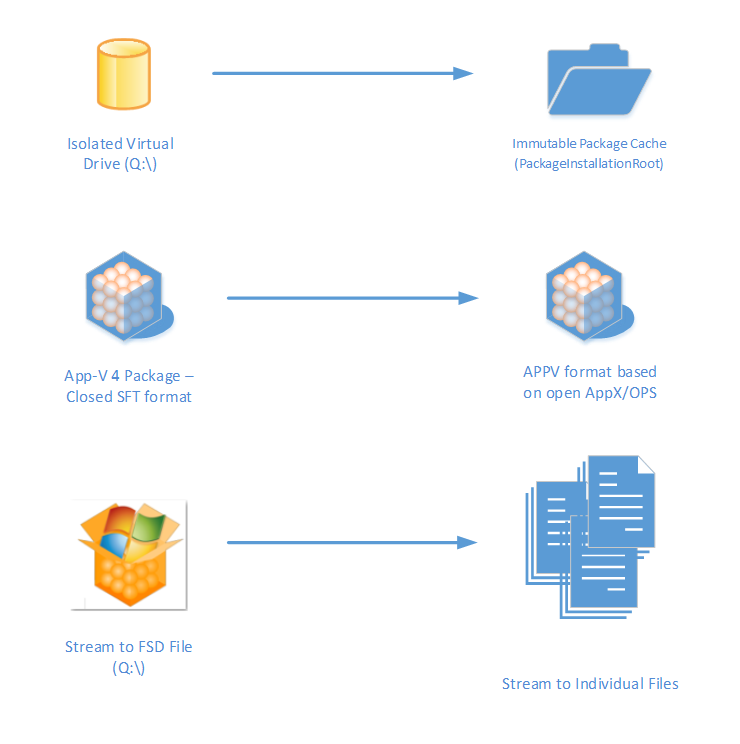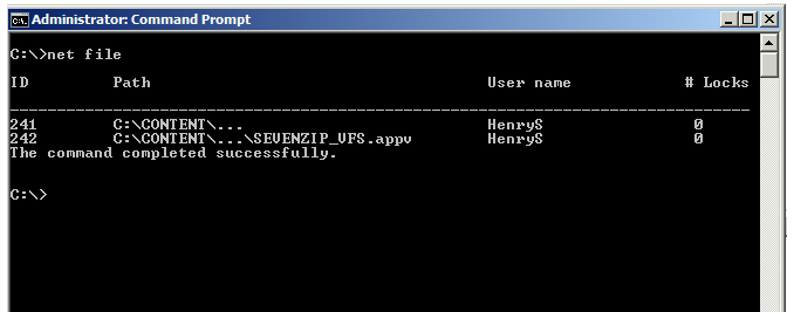App-V 5: On Streaming
Now that Hotfix 4 for App-V 5.0 SP2 has been out now for several weeks, many of you have likely already seen our Updated Guidance for Performance Recommendations now available on Technet (https://technet.microsoft.com/en-us/library/dn659478.aspx.) It almost goes without saying that the new stream-to-disk model of populating individual state-separated sparse files at the native NTFS level yielded an approach to streaming that came with some caveats and albeit, a few glitches, at first.
It was a big change and a lot of the move from an isolated virtual drive to a state separate immutable package cache directory meant that there would have to be some re-engineering and with that brought changes – including changes at the philosophical level.
The basic concepts remain the same. They are just implemented differently:
In addition, a switch to the use of standard protocols already deeply rooted into Windows occurred completing the change of the streaming landscape. Many customers have asked me to clarify some of the new performance recommendations and the rationale behind some of the choices.
SMB or HTTP?
Some concepts require us to rethink how we implement our packages. For example, intra-datacenter streaming, especially for Shared Content Store scenario will yield much better results with SMB or file-based streaming. HTTP, or web streaming, will be better suited for standard streaming especially to devices external to the data center. In the case of Internet-facing scenarios, especially where data would need to be encrypted, HTTPS would be the way to go.
Feature Block 1
When the package needs to stream content for a first launch, the StreamMap.xml file (which is already cached upon publishing) will be parsed.
Once all of the files listed in FB1 (the actual element is PrimaryFeatureBlock) are downloaded, the application can proceed to launch. Our updated guidance mentions the concept of automatic stream faulting upon first launch (which is what always happens in SCS) where if there is no FB1 (like in the example below) the file will be instantly pulled down to populate the sparse file and loaded into memory thus often resulting in a much quicker launch (especially in a scenario where HTTP streaming is being used.) This significant performance hit does not reveal its ugly head as drastic with SMB streaming as it is often going to be faster especially over higher speed LAN links.
Remember – this also not a simple file retrieval process. The files are inside a compressed package. So extraction also has to occur and that’s going to be somewhat less costly with SMB than with HTTP.
When the application launch succeeds, the PreviouslyUsed value in HKEY_LOCAL_MACHINE\SOFTWARE\Microsoft\AppV\Client\Streaming\Packages\<GUID>\<GUID> wil be marked to 1. This also means that if you are using the default configuration, the Autoload settings mean that a background load task will be queued to begin. This will not happen in SCS mode. No Autoload, No FB1.
Removing/Updating Package Content with Opened Packages
We use metadata to govern version and package lineage from a streaming perspective and as a result, many administrators are choosing to forgo the appending of package files to include a version stamp. That is certainly an option but overwriting content on package stores may yield problems. Usually it relates to packages being in use. There are several tools at the ready to verify on your content servers what files may still be open for streaming by clients. You can use the Handle.exe tool for Sysinternals https://technet.microsoft.com/en-us/sysinternals/bb896655 to view and close open packages although I would not advise closing packages, especially in Shared Content Store scenarios as that could create application crashes and lead to data loss.
Since Anonymous authentication is not supported and access is authenticated, you can use the handle command with the –u switch to get user information. You could also revert to the old fashioned NET FILE command if you are using SMB for streaming as well.
It will also reveal the user.
I’ve noticed, and you likely have as well that when working in stream-to-disk scenarios, the handles to the packages can remain open for quite a while – even after the file has been fully cached sometimes. That is actually by design. Each App-V Client will maintain a connection to the package file for each user on a per-package basis. Like the case with previous versions of App-V, this means that there will be a lot of sessions coming from RDS clients. BUT – unlike previous versions of App-V, we do NOT have to deal with limitations caused by ephemeral ports, individual connection on a per-application basis, constant re-authentication on each application launches. There will be one session per package/user combination for stream-to-disk scenarios. NOTE – In Shared Content Store mode you may see multiple sessions depending on stream faults.
With these improvements come some caveats. The client will keep an open handle to the file when using SMB streaming. This is because these sessions involve connect to compressed packages and that can be an expensive process if you need to consistently reconnect. As a result, the App-V Client will cache open sessions for up to 30 minutes past use. I my opinion, this is a small price to pay for the added benefits and scalability that come with the changes.
Comments
- Anonymous
June 30, 2015
~ John Behneman | Senior Support Escalation Engineer Hello everyone, John Behneman here again. I’d like - Anonymous
June 30, 2015
~ John Behneman | Senior Support Escalation Engineer Hello everyone, John Behneman here again. I’d like




